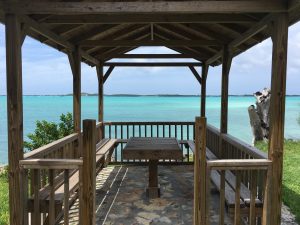
Georgetown
We finally made it out of Luperon! After weeks of waiting out high winds and squalls, Chris Parker predicted a decent weather window and gave us the all clear to make the jump up to the Bahamas. Winds were still going to be high, as the diurnal pattern of heavy winds every late day/early evening was showing no signs of abating, but at least the squalls had passed. And we were moving west, going in the right direction for a comfortable ride.
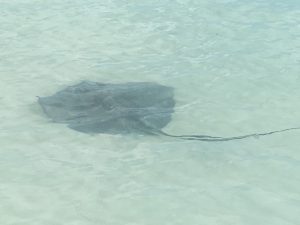
Stingray
We had hoped to be sailing with Tuvalu, but Tobias was still really sick. He had come down with a nasty bout of food poisoning after eating bad anchovies and hadn’t left the boat in five days. We finally got our yoga teacher, Veronique, who also happens to be a nurse, to pay him a visit. She made us all feel a bit better when she reported that he was absorbing enough electrolytes and fluids from what he was consuming that he didn’t have to get to a medical clinic. We stayed an extra day and were thrilled to see him on shore eating solid foods for the first time in days.
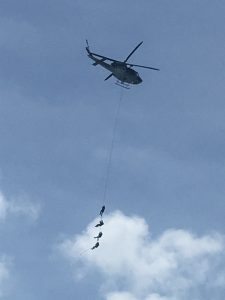
Yikes! Unknown training exercise
And that was it – we were off. We had the predictable big seas and high winds the first day/evening, but we still wound up making 6 knots+ under a 1/3 jib and it was a decent ride, if a little rolly. After the first 24 hours both the winds and the seas calmed further, so we opted to skip the first possible points of landing – Turks & Caicos (we had already been there previously anyway), and Mayaguana in the Bahamas. By the end of the second 24 hours we opted to skip Rum Cay, Conception Cay, and even Long Island. However, we knew we weren’t going to make it to Georgetown until the middle of the night, and you don’t try to pass through reefs in the dark (daylight and visual piloting is required to spot coral heads and rocks that could otherwise do some damage to the keel). We tucked around the northernmost point of Long Island and anchored just behind the reefs in Calabash Bay. It was just enough to block both the wind and the swell, so it was a great place to rest – and to celebrate our longest offshore run yet as a couple -340 miles! (We’ve done longer obviously, but it’s always been with crew). We’ve nicknamed the autopilot “Ray” (short for the manufacturer Raymarine), our official third crew member that makes these longer hauls much more possible.
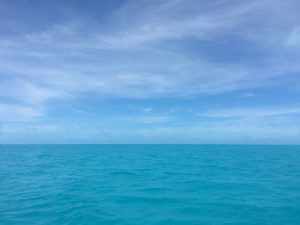
Bahamas blues
We got up the next morning to grey skies. The first tropical storm of the year, Alberto, was moving up the coast of Florida. Though he was in the Gulf of Mexico, winds and rain could be felt as far as the Bahamas. We were pretty far away from any potential action, but decided to sit tight for the day. Sure enough, mid afternoon we got an hour of high winds (gusting well into the 30’s) and torrential rain. Could we have sailed in it? Sure. Would it have been a messy and potentially dangerous entry to the Bahamas. Oh yes.
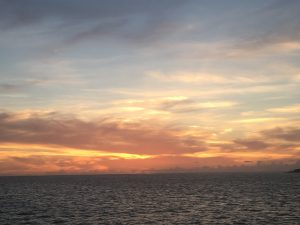
Sunset
Sunday we finally made our way over to Georgetown. From the entry cut in the reefs, it’s still a few miles of zigzagging between reefs and other shallow spots to find your way to port. Happily, there was plenty of room to drop anchor, mostly because it’s now low season. There were maybe twenty boats total in the harbor, and in high season there would be 400+ – really glad to not have to compete with that! As it was, we were a little too aggressive with the depth of our anchoring. We woke up at 2 AM to the slight jerking of the boat as we scraped bottom at dead low tide. No damage done, and as soon as the tide came up we were fine again. The next morning as we moved out a bit to a slightly deeper spot, Trip pointed out that it was a full moon – tides are always at an extreme during those days so the low would have been especially low. The color of the water is the most exquisite shades of blue anyway – during a full moon those shades of blue are still apparent at 2 AM!
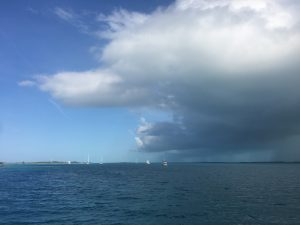
Stormy weather blowing past
Monday morning we went into Georgetown to clear in. Sniff, sniff, this was the last foreign country we’d be entering as part of this year-long adventure. We found laundry (whew, hadn’t been able to do laundry the last week in Luperon due to a broken water main for the entire town) and a local cell phone store. Cruising friends on Contigo had given us their Bahamas SIM card. For only $30, you get 1,000 minutes of talking, unlimited texts, unlimited WhatsApp, and 15 GB of data. Hello – Verizon, AT&T? Talk about a deal.
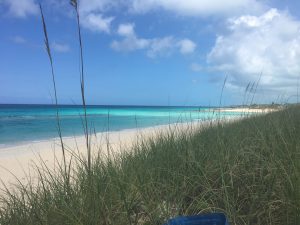
Stocking Island, Atlantic side
We had lunch at the Driftwood Café, only to find that they don’t serve alcohol. I was so hungry I didn’t care, but Trip wasn’t pleased. And then we found out they were missing several dishes featured on their menus. I gulped down a $13 caesar salad (ouch, get used to really expensive eating in the Bahamas!) and we went in search for a beer and to explore more. Georgetown, though one of the major towns of the Bahamas, is walkable in an hour. We stopped for a beer at Eddies, to find that Kalik (the local beer) is about as dry and boring as the Medalla in Puerto Rico had been. Luckily we also discovered Sands, another local beer that’s quite tasty.
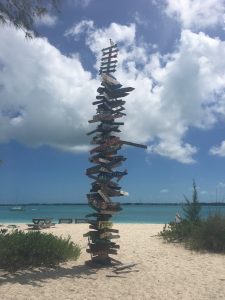
Chat n’ Chill, Stocking Island
We took the laundry and some groceries back to the boat and got organized, then came back ashore for dinner. Eddies was featuring a ‘rake & scrape’, BBQ dinner with a live band. The BBQ was amazing, and the band was quite lively. Loud, but not so loud you didn’t enjoy yourselves. And we danced! Funny enough, when we were wandering through town the next day, members of the band recognized Trip and called out to tell us where they were going to be next so we could come back for more dancing! How often does the band recognize you????? Only Trip.
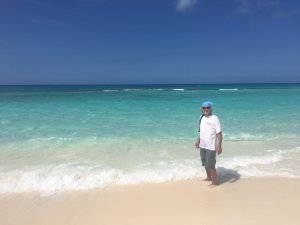
Trip at the beach
Winds were just high enough to make for wet dinghy rides, so we opted to bring Kalyra a mile across the bay to anchor off Volleyball Beach on Stocking Island. There we dinghied ashore to check out the Chat n’ Chill, a beach front bar much like Foxy’s in the BVI. Sandwiches were tasty, beer slid down easily, and it was fun to walk the beach watching all the sting rays swimming in the shallows. We even went out the back beach, waded across a shallow spot, and crossed over to the Atlantic side. It was a shallow beach, but it went on for miles and the water crashing over the reefs was spectacular.

Recent Comments